
| 
|

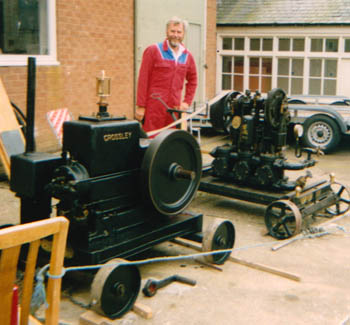
Friends Newsletter No. 58
April 2014
Friends are the guardians of Malvern's water heritage (Malvern Gazette 1 March 2013 p.14). We are an independent voluntary group who relentlessly promote research, conservation and celebration of the Springs, Spouts, Fountains and Holy Wells of the Malvern Hills and of Great Malvern as a Spa Town.
Good home wanted for the Owls Hole Pump and Engine
The Owls Hole Pump once pumped Malvern Hills spring water to the area around British Camp. The water was the principal supply for numerous houses in the neighbourhood. The pump is a triple throw, reciprocating, open crank, positive displacement pump. Numbered 84135, it was made in 1927 by Joseph Evans, Engineers of Wolverhampton. At the time of its installation, c.1927, the pump was powered by a Crossley PO 1050 paraffin engine. The pump remained in situ in a derelict pumping station until 1994 when it was removed for renovation. After negotiations with the owners, the original Crossley PH 1050 engine was also recovered from British Camp Reservoir water filter station in February 1995. The restoration work was completed and on May 15th 1995 it was decided to align the Crossley engine with the Owls Hole pump, start up the engine and belt drive the pump for the first time in 50 years. Thereafter the two artifacts of Malvern's Water Heritage have given numerous public demonstrations and displays, particularly at the County Museum at Hartlebury.
These two units are in store and have not seen the light of day for several years. We now seek a new custodian for them who would be able to bring them back to life once again. If you know of a suitable enthusiast do put us in touch and we will happily make them available to the right person.
More details on our web site - do a Key Word search for Owls Hole Pump. In the picture - Bruce with the pump and engine at Hartlebury Museum.
Holywell Chapel for sale
Do you recall in the last Newsletter we gave some more details on the recently converted Wells House Chapel? We recently saw it advertised for sale. It includes five bedrooms and three bathrooms and an amazing location with magnificent views. The price from Allan Morris and Ashton is £800.000. 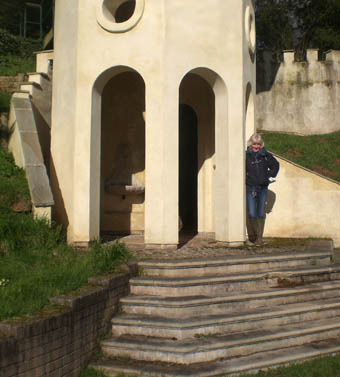
Kyre Park Fountain and Grotto
A key element of the landscape feature known as a grotto is the sacred or mythological spring. In Newsletter 56 we considered the grotto and this has created interest in the subject.
Worcestershire has its fair share of large estates with grottoes, including Kyre Park near Tenbury. Malvern also had a grotto with a Malvern Water source known as the Gothic Well, recently unfortunately destroyed. Arthur Young was one of numerous 18th century landscape critics who recorded their observations in his writings. At the time many children of the aristocracy went on the "Grand Tour" through European cities in early adulthood. Here they saw grandiose grottoes and some shipped back souvenirs in the form of statuary to recreate the grotto on their own estates. Others employed advisors to guide them in grotto design in their country parks. Young's comments on their creations provide a valuable guide as to the occurrence and quality of grottoes in his time.
In recognition of Young's endeavours we have initiated the Great British Grotto Grading scheme. This provides a quick and easy quality guide to grottoes that exist in the 21st century. Hopefully it will tempt you to seek out historic grottoes and forward details for grading.
For details of the scheme go to our web site and do a Key Word search for Grotto Grading. In the picture Cora checks out the mysterious lakeside entrance to the grotto and the drinking fountain at Kyre Park Tenbury Wells WR15 8RP. Now graded 7 and worth seeking out.
Drownings in water-filled quarries
Once again our recent articles have prompted comment from Friends about how you deal with young people drowning in Malvern water filled quarries. A friend has written to us as follows:
Tombstoning injuries need to be publicized. As you say, education, education, education, for a start to counterbalance the narcissistic desire of kids to put photos on social media, showing them doing something risky (a.k.a. daft).I do think we need a national campaign about this - not least because so many local authorities are struggling to maintain public swimming facilities where youngsters can learn to swim properly. At the same time, without making them afraid of the water, kids need to know just how many people die from accidental drowning each year: who all, no doubt, believed it couldn't happen to them.
There's also another physiological response that should be better known: until infants are something like three years old, they retain the mechanism that stopped them breathing in the womb. When a baby's face is immersed in water, it automatically stops breathing. Thus, if a small child falls so that its face ends up in a pond or even a puddle only a few inches deep, the child is likely to drown because the autonomic response from its brain hasn't been replaced by the learned response to take its face out of the water. Small children continue to die because people don't realize the shallowest ponds can kill them.
A Romantic Spring on the Malvern Hills?
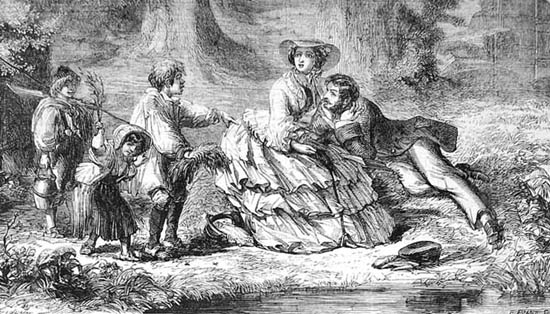
Before reading the following paragraph study the picture to see if you can interpret what is going on. Is it smutty or romantic?
The picture above appeared in the Illustrated London News in 1856, adjacent to a picture that was captioned as a scene from the Malvern Hills. This suggests that this picture was similarly located. The first question is where is the spring that appears in the foreground? The original caption indicates that the lady is being told by the kids that she is sitting on a hornets nest. The second question is, was the hornets nest real or was it an innuendo for something equally as stimulating that she was astride in the woods? We will probaly never know, but it may explain a little more about what the couple were up to before being disturbed by the local mischevous urchins. If you can shed any more light on this intiguing image or think of another caption, do let us know and we will publish the details provided it is not too rude.
Memorial to a Dr James Wilson Memorial?
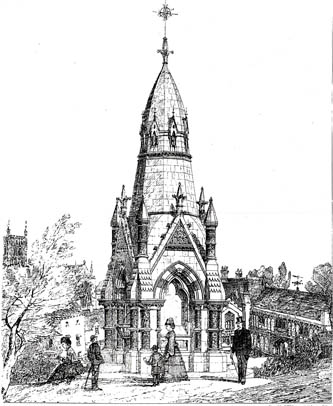
What did Dr James Wilson do wrong? He introduced hydrotherapy to Malvern in 1842 and brought the dynamic Dr James Gully in his wake. To Wilson can be attributed, to a great extent, Malvern's fame and fortune; its increase in population; delightful architecture; its development as a posh spa town. When he died it was immediately decided that the great man should be awarded a great memorial. A public clock was suggested, but wasn't considered worthy enough. It took TEN YEARS before the Wilson Memorial Fountain was erected. The Haddon brothers' original drawing shows it on a site near the town centre, just opposite the Crown Hotel, where Wilson began his hydropathic career, and overlooking the ancient Priory Gatehouse. But it was shoved away on the junction of Abbey Road and Priory Road where no-one went; hardly anyone saw it; hardly anyone used it.
By February 1879 there was no drinking cup at the fountain. By 1882 the fountain had been dry for some years. A letter to the local newspaper in 1897 accused the fountain of being neglected; there was no water, no cups, and weeds growing all-round the edifice. In October 1904 it was recommended that the fountain should be cleaned up and kept clean. It was far too dirty for anyone to use; and the young trees growing through the paving stones should be removed. Wilson's white elephant was demolished in 1948.
Now a new memorial to that original memorial is to be installed on the same site. Who will see it? Who will visit? Who will ever know it is there? What did Dr James Wilson do wrong? Why is he being punished and banished? This new 'memorial' brings to mind Lord Shaftesbury's comments in 1852 on the Duke of Wellington's hugely elaborate State funeral: "..... hardly impressive; signs of mortality but none of resurrection." Surely if we want to remember this man and give him an afterlife, a memorial to him (not to a previous memorial!) would be put near the Crown Hotel, where no one can fail to see it. It will show the original Crown Hotel with an image of The Old Original - Dr Wilson - and some appropriate text. And then we can name an avenue, close or street after him; and then perhaps we can even rename Malvern Community Hospital The James Wilson Memorial Hospital.
Holy Water versus the Witches of Malvern
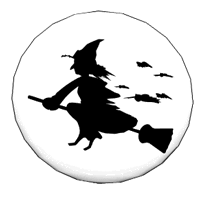
When investigating gold in the Malvern Hills we came across Defoe's 18th century text as reproduced below. The paragraph before the Malvern gold text mentions two things. Firstly the ancient religious establishment the Monastery and secondly the Legend of Wonders performed by the Witches of Malvern. Is there a connection between the two? Investigating this further what better source than Burton's Anatomy of Melancholy, first published in 1652.
In this tome, witches are described as instruments of the devil motivated by lust and revenge. Their powers are ambivalent in that they can cause distressing conditions as well as alleviate disease and suffering. They are able to hurt and infect men and other living creatures and plants; make women abortive and cause barrenness; steal children from the cradle and replace them with deformed infants, cause melancholy and other mental illness, etc. On the good side witches can make men feel no pain on the rack; prevent wounding with musket or rapier; cure dried up women’s paps, gout, palsy, apoplexy, falling sickness, etc. The witch’s powers also transcended other "normal” physical abilities as well as those of the physician. They could fly to meet where they wish; walk on fire; speak strange languages, cause tempests and storms and cause vomiting of metallic objects. Such women walked the Hills of Malvern but ironically did not steal gold or silver.
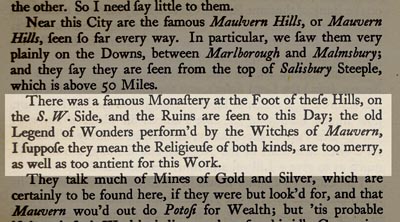
Left: Daniel Defoe's comments on the Malvern Witches1827.
The counter to such witches activities was God. The church provided saints for healing, and each and every complaint had its own healing saint. Supporting the role of saints was a variety of accessories such as holy water, relics, crosses, beads and amulets. This is where the confusion appears to arise. There was a financial cost to resorting to religion as well as uncertainty about the role of saints as agents of God, especially as counterfeit miracles were apparent. Why pray to saints, rather than God directly? The dilemma was both God and the Devil had their agents and each was attributed with amazing powers. Before the reformation it is reputed that St Werstan’s relics were in the Priory Church in Malvern and no doubt the local holy water was highly sought after. The possession of high profile relics brought pilgrims and wealth to the church and Malvern was no exception. The witches on the other hand offered an alternative approach to physical and mental welfare. Meanwhile the physician, lacking scientific knowledge, waited in the wings for the advances in medicine that were to come in subsequent centuries.
Water at Ellerslie
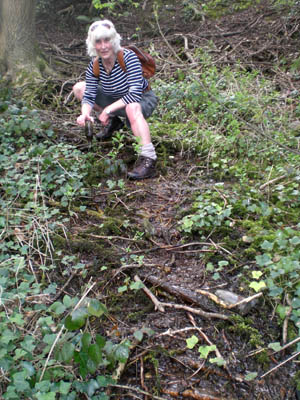
We were alerted to the spring water that was flowing in the vicinity of Ellerslei Fountain (Site No. 90) recently. This prompted a field investigation and an opportunity to tidy up the site. Ten yards north of the fountain, water was running down the bank from behind the fountain. Climbing through the woodland, we found the source just below the Wyche Road. This spring has no doubt erupted as a result of the high water table, following the exceptionally wet early part of the year. Have a look soonest as it will likely dry up with the summer coming. In the picture Cora delights in Malvern's new found spring.
News Flashes - Mulberry Trees and Well Decorating
Good news, the mulberry tree saplings planted recently in Priory Park are sprouting leaves. Also do not forget it is Well Decorating soon. The theme is Peace and the timing is weekend of third and fourth of May.
Email: springs@thespas.co.uk (click here to send an email)
Website: Click Here
SUPPLEMENTARY INFORMATION
 Newsletter Archive which can also be accessed from our WEB SITE INDEX.
Newsletter Archive which can also be accessed from our WEB SITE INDEX.
Friendship - There is no charge made for joining Friends of Malvern Springs and Wells. Just let us have your email address and we will send our newsletters, which are usually two monthly. Please be aware that some email addresses block large circulation emails. Do feel free to participate in our activities by contacting us below.
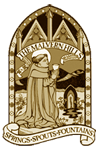
Best wishes, Cora & Bruce
Tel. 01737 213169 email bruce@thespas.co.uk
Tel. 01684 561215 email cora@malvernspa.com
1) TOPOGRAPHICAL LOCATION:
Malvern Hills - arguably Britain's original National Park
3) INFORMATION CATEGORY:
History & HeritageFriends Newsletter


